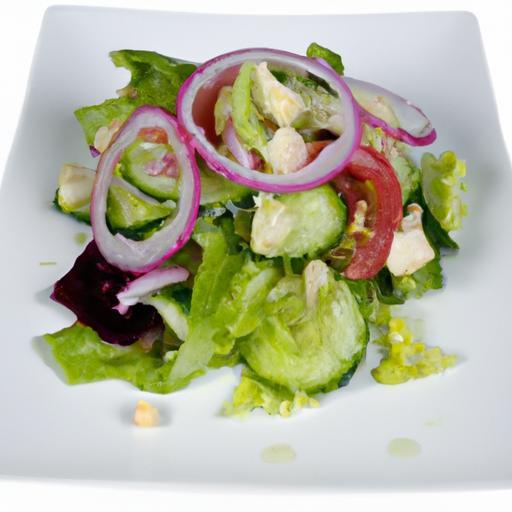There’s something almost magical about a well-made vinaigrette-a harmonious dance of tangy vinegar and luscious oil, kissed by herbs and a hint of sweetness. Yet, just as quickly as you whisk it together, that glossy emulsion can betray you, breaking apart into layers of oil slick and vinegar puddles. Why does this happen? And how can you keep your vinaigrette perfectly blended, every time? In this article, we’ll unravel the science behind why vinaigrettes separate and share expert tips to help you create a smooth, stable dressing that clings lovingly to your greens instead of running away. Get ready to say goodbye to frustrating drips and hello to salad success!
Understanding the Science Behind Vinaigrette Separation
Why does my vinaigrette separate? This common question often frustrates even the most enthusiastic home cooks. The truth lies in the natural science of emulsions-mixtures of oil and vinegar that resist blending due to their different molecular compositions. Oil molecules are hydrophobic (water-repelling), while vinegar is primarily water-based. Without proper technique and ingredient selection, these components will separate as they try to revert to their original states, creating that characteristic split in your dressing.
Choosing the Right Ingredients for a Stable Emulsion
Successful vinaigrettes start with thoughtful ingredient choices. Using high-quality extra virgin olive oil or nut oils provides the rich flavor and smooth texture your palate craves. The choice of acid matters too-balsamic, red wine vinegar, or freshly squeezed citrus juice each lends unique taste and can influence how well the emulsion holds.
Adding natural emulsifiers such as mustard, honey, or mayonnaise stabilizes the mixture by binding the oil and vinegar together. For a silky, stable blend, always measure your ratios carefully; a classic vinaigrette often uses a 3:1 oil-to-acid balance, but you can adjust this to taste and stability preference.
Mastering Techniques to Achieve a Perfect Blend
The key to a harmonious vinaigrette lies in whisking or blending vigorously to disperse tiny oil droplets uniformly throughout the vinegar. Using a bowl and a balloon whisk or an immersion blender accelerates emulsification. Pouring the oil slowly, in a thin stream, while constantly whisking allows the oil to suspend evenly rather than pooling.
Room temperature ingredients also ensure seamless blending. If your oil is too cold, it could harden and disrupt the smooth texture. Experiment with gentle heat or temper the oil if necessary to maintain fluidity.
Creative Tips to Keep Your Vinaigrette Smooth and Fresh Longer
Keeping your vinaigrette smooth beyond the initial mixture requires smart storage and occasional agitation. Storing it in a tightly sealed glass container in the refrigerator helps preserve freshness and prevents oxidation. Before serving, simply shake or stir the vinaigrette vigorously to restore its creamy consistency.
Consider incorporating creative stabilizers like ground flaxseeds, blended avocado, or silken tofu for thicker, nutrient-rich dressings that stay emulsified longer. For an added layer of flavor and texture, fresh herbs minced finely also contribute subtle emulsifying properties.
Prep and Cook Time
- Preparation: 10 minutes
- Emulsifying: 5 minutes
- Total Time: 15 minutes
Yield
Approximately 1 cup (serves 4-6 as a salad dressing)
Difficulty Level
Easy – Perfect for home cooks of all skill levels
Ingredients
- ⅔ cup extra virgin olive oil, room temperature
- ¼ cup red wine vinegar or apple cider vinegar
- 1 tablespoon Dijon mustard
- 1 teaspoon honey or maple syrup (optional, for balance)
- 1 small garlic clove, minced (optional)
- Salt and freshly ground black pepper, to taste
- Fresh herbs like parsley, chives, or thyme, finely chopped (optional)
Instructions
- Combine the mustard, vinegar, honey, garlic (if using), salt, and pepper in a medium bowl.
- Whisk the mixture vigorously until fully blended, creating a smooth base.
- Slowly drizzle the olive oil into the bowl in a thin, steady stream while continuously whisking to encourage emulsification.
- Continue whisking until the vinaigrette thickens and forms a uniform creamy consistency.
- Stir in fresh herbs if desired, and adjust salt and pepper to taste.
- Transfer to a clean glass jar with a tight lid. For best results, refrigerate and shake before each serving.
Chef’s Notes
- Substitute oils: Try walnut or avocado oil for unique flavors, but consider their emulsifying properties.
- Make-ahead tip: Prepare vinaigrette up to 48 hours in advance for flavors to meld; always shake well before use.
- If separation occurs: Don’t worry, just whisk or shake again to re-emulsify instantly.
- For creamier consistency: Blend the vinaigrette in a food processor or use an immersion blender.
- Experiment: Add a splash of soy sauce or citrus zest for exciting variations.
Serving Suggestions
Serve your perfectly blended vinaigrette over crisp garden greens, roasted vegetables, or grilled seafood for vibrant flavor. Garnish with a sprinkle of cracked black pepper and a few fresh herb leaves to visually elevate your dish. Pair with warm, crusty artisan bread to soak up any leftover dressing-the perfect finishing touch for any meal.
| Nutrient | Per Serving (2 tbsp) |
|---|---|
| Calories | 120 kcal |
| Protein | 0 g |
| Carbohydrates | 1 g |
| Fat | 14 g |
Related resource: Discover more about emulsions and dressings in our comprehensive emulsification guide.
For further scientific insight, explore the article on emulsions and food science by ScienceDaily.

Q&A
Q: Why does my vinaigrette separate so quickly after I make it?
A: Vinaigrette is essentially an emulsion-oil and vinegar that don’t naturally want to mix. Since oil is hydrophobic (it avoids water-based liquids like vinegar), the oil droplets eventually cluster together and float to the top, causing that inevitable separation.
Q: Is separation a sign my vinaigrette has gone bad?
A: Not at all! Separation is normal and doesn’t mean your vinaigrette is spoiled. It just means the oil and vinegar have parted ways. A quick shake or stir will reunite them-like a little flavor reunion party in your bowl.
Q: How can I keep my vinaigrette from separating so fast?
A: The trick lies in creating a stable emulsion. Try whisking the oil and vinegar vigorously while slowly adding the oil to help tiny droplets suspend evenly. Adding an emulsifier-like a teaspoon of mustard, honey, or even a bit of mayo-acts like a peacekeeper, helping oil and vinegar stay blended longer.
Q: Does the type of oil or vinegar affect separation?
A: Absolutely! Thicker oils like extra virgin olive oil tend to emulsify better than lighter oils, and balsamic vinegar can sometimes help create a creamier texture. Experimenting with different varieties can improve stability and flavor.
Q: Can temperature influence my vinaigrette’s blend?
A: Yes! Cold ingredients tend to make the oil solidify and separate faster. Let your vinaigrette come to room temperature before using, or store it at room temperature if you plan to use it within a day. If chilled, give it a good shake before serving.
Q: Is there a foolproof method to make a vinaigrette that stays blended?
A: While no vinaigrette stays blended forever, emulsifiers are your best bet. For extra staying power, try using an immersion blender or jar shaker to whip the dressing thoroughly. Adding creamy ingredients like avocado or blending in an egg yolk (think classic French vinaigrettes) can also create a luscious, stable emulsion.
Q: What’s the best way to store vinaigrette to maintain its quality?
A: Store it in a sealed jar or bottle, ideally in the fridge. Give it a good shake before each use. If you notice any off smell or mold, toss it out. Otherwise, separation is just nature taking its course-no harm done!
Keep these tips in mind, and your vinaigrette will be the perfect harmony of tangy and rich every time you drizzle!
Concluding Remarks
In the delicate dance of oil and vinegar, separation is inevitable-but understanding the science behind your vinaigrette’s tendency to part ways is the first step toward a perfectly harmonized dressing. By mastering the art of emulsification and adding a few trusty allies like mustard or honey, you can keep your vinaigrette blended and beautiful. So next time you drizzle that vibrant splash of flavor over your salad, relish the creamy consistency you’ve crafted, knowing that with a little technique and patience, your vinaigrette will no longer play hard to get-but instead, blend seamlessly every time.


